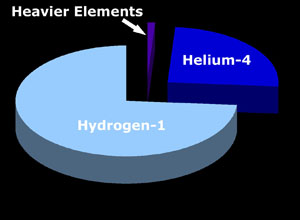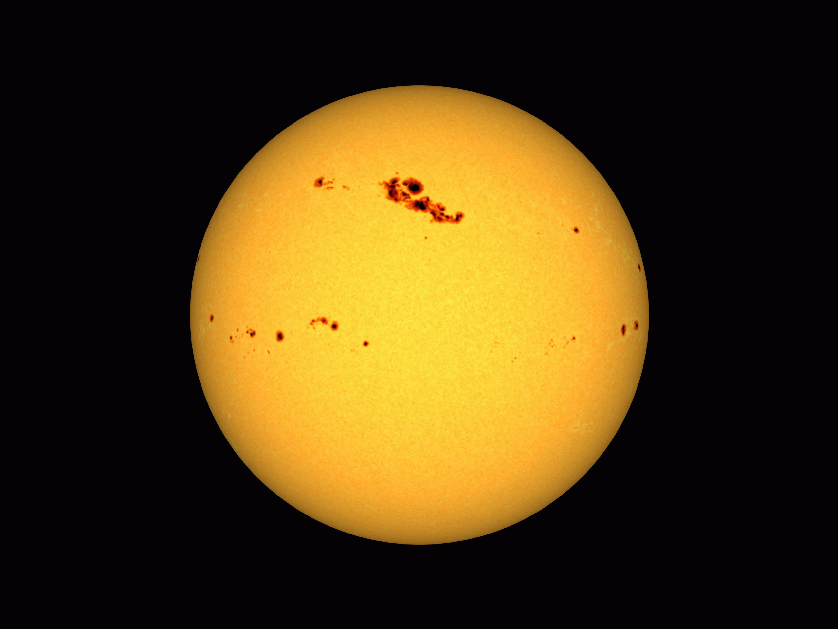Make the internet a better place to learn
What is the parallax formula and how is it used to calculate the distance between two stars?

Answer:
The parallax formula states that the distance to a star is equal to 1 divided by the parallax angle,
Explanation:
Parallax is a method of using two points of observation to measure the distance to an object by observing how it appears to move against a background. One way to understand parallax is to look at a nearby object and note its position against a wall. If you look with just one eye, then the other, the object will appear to move against the background.
Because your eyes are separated by several centimeters, each eye has a different perspective of where the object is relative to the background. The closer the object is, the more it appears to move relative to the background. This is true in astronomy as well, but on a much larger scale.
In astronomy, the distances to other stars is too great to measure using two objects on the Earth's surface. Lucky for us, the Earth itself moves. If we made two observations of the same star on opposite sides of the Earth's orbit, we would have a separation of
This is enough to get a noticeable angle,
Since the star will be very far away, we can make the assumption that
Astronomical units are not the most convenient units to work with, though, so instead we define a parsec to be the distance to a star that shows
Where
If the Hubble telescope can take excellent pictures of stars and galaxies forming millions of light years away, why can't it take a good picture of Pluto?

Answer:
The Hubble telescope has an angular resolution of
Explanation:
While researching this answer, I came across this article which provides a more in depth answer to the question.
Hubble uses a special type of camera called a CCD, or charged couple device. These cameras use a grid of "bins" which collect and count photons. These "bins" correspond to pixels in the resulting image. If we look at a Hubble image of Pluto from 1996, we can see these pixels.

Currently, Hubble's resolution is about
Pluto's angular size changes as it orbits the sun. The closer it is to the Earth, the larger it appears. At its closest, Pluto is
This is the angular size in radians. If we convert to arc-seconds, we get;
Which is about
 )
)
What lies beyond the universe?
Answer:
Nothing, at least as far as we know.
Explanation:
The most distant reaches of the visible universe, the known universe, sit some 45 billion light years away. They are early constellations and stars. Problematic to that is the fact that they are moving away from us and that motion is accelerating. This 45 billion light years away is in all directions possible from our galaxy.
But you have to consider that we live in a universe that is approximately 13.8 billion years old and accept the fact that nothing can travel faster than the speed of light. That should mean that we cannot see anything more than 13.8 billion light years away.
Astro-physicists have explained this with the theory that in the first few seconds of its existence, the universe expanded to about one half the size it is today. That means by default the original expansion of the universe happened at a speed far greater than the speed of light to go from zero to 31 billion light years in size in a matter of seconds.
But could there be more galaxies beyond the 45 billion light years we know of? Yes!
Our ability to "see" these great distances and calculate how far away the most distant objects are rely upon our understanding of the red shift and the accuracy of the instruments we using in measuring these distances. We are in the literal infancy of such discovery.
There also exists the theory of the "multi-verse." In this theory there are an infinite number of universes and ours is simply one. Confounded to those who would like to deny such a possibility is the fact that the math supports the theory.
Does wavelength of light change in different mediums?

Answer:
Yes, the wavelength shortens as it passes through an optically dense medium.
Explanation:
Physicists refer to light as electromagnetic waves, referring to the fact that light is made up of two oscillating fields; one is magnetic, and the other is electric.
 )
)
Light travels fastest in a vacuum. When the light encounters a medium, such as glass, the charged particles that make up the glass interfere, slowing the wave down. The wave continues to oscillate at the same rate, however, so as the wave slows, the wavelength must contract.
)
In the image above,
What is the cooler, darker area on the surface of the sun?

Answer:
Sunspots
Explanation:
Sunspots are dark areas in the sun, they appear dark because they are cooler than the rest of the sun's surface.
Sunspots are Storms in the lower atmosphere of the sun. They may be small as
The number of sunspots that appear on the sun at any one time is always changing. But periods of very active sunspot activity seem to occur every
What were the Apollo Missions?

Answer:
The Apollo missions were the United States mission to the moon.
Explanation:
There were three stages to NASA's journey to the moon. The first stage, the Mercury program, was designed to get American astronauts into space. The second stage, the Gemini Program was meant to prepare the astronauts and equipment to go to the moon. Finally, the Apollo program brought astronauts to the moon.
The Apollo missions relied on the Saturn IB and Saturn V rockets. The Saturn V was the rocket that went to the moon. There were three booster stages to get the rocket into space, an instrument unit, and the Apollo spacecraft, which housed the astronauts.

Apollo 11 was the mission that brought Neil Armstrong and Buzz Aldrin to the moon. The missions leading up to Apollo 11 were all test fires and orbit missions. Apollo 12 and Apollo 14 through 17 all landed on the moon as well. Apollo 13 was supposed to be a moon landing, but an unfortunate equipment malfunction kept it from landing.
Apollo 1 was an equipment test early in the program. A spark inside the capsule caused a fire that killed astronauts Gus Grissom, Ed White, and Roger Chaffee. It was a terrible tragedy, and created a lot of controversy over NASA's ability to land on the moon.
How are the north and south celestial poles related to the earth's axis of rotation?

Answer:
The direction of the north and south celestial poles are based on the Earth's axis of rotation.
Explanation:
Astronomers need a coordinate system to define the positions of stars. Declination is the angle between the equator and the star, right ascension is the hour angle from the Vernal Equinox to the star.
The direction of the Vernal Equinox is the direction in the equatorial plane from the centre of the Earth to the Sun as it crosses the equator in March. The north celestial pole is then the direction from the centre of the Earth along the axis of rotation northwards.
The problem is that neither the Vernal Equinox direction or the direction of the Earth's axis of rotation are fixed. Both directions are constantly changing due to nutation caused by the gravitational effects of the Sun, Moon and other planets.
To get around this the coordinates of stars are given along with a reference date. A commonly used reference date is the J2000 epoch. The direction of the Vernal Equinox and the North celestial pole are then defined to be the directions as they were at 2000-01-01 12:00:00 TT (note the time is midday not midnight). Where TT is Terrestrial Time which differs from UTC by about a minute.
The current positions, the pole of date and the Vernal Equinox of date are calculated using power series which give the directions at any given time relative to the J2000 epoch.
So, the direction of the North celestial pole is the position that the Earth's axis of rotation was pointing at a particular moment in time such as the J2000 epoch 2000-01-01 12:00:00 TT.
Do stars have hydrogen and helium or hydrogen alone on its birth?

Answer:
All stars are composed of hydrogen and helium, and depending on age and generation, they may have varying amounts of heavier elements.
Explanation:
According to the big bang theory, when the universe cooled enough for atoms to combine, about 75% of the mass of the universe was hydrogen, 25% was helium, and then there were trace amounts of lithium. This was the concentration of matter that formed the very first stars in the universe, and it has not changed much since then.

Hydrogen is the easiest element to fuse since it requires the least amount of energy to overcome coulomb repulsion. That's why all stars begin by fusion hydrogen into helium, and spend most if not all of their life doing so. More massive stars will also create heavier nuclei inside their cores, so as the concentration of hydrogen goes down, the concentration of heavier elements increases.
When stars die, they scatter their atoms back into space, and new stars are made of those atoms. Therefore, over time, new stars will have greater and greater compositions of heavier elements. We call this composition, metallicity.
The Sun, which is considered to be metal rich, has a metallicity of .02, meaning that only 2% of the mass of the sun is not hydrogen or helium. So the composition of stars is still almost entirely hydrogen and helium.
What is the name of the cloud that contains many comets outside of the solar system?

Answer:
Most comets are thought to originate in the Kuiper belt and the Oort cloud.
Explanation:
Comets are often described as "dirty snowballs," being composed mostly of a loose clump of ice and rocks. They spend most of their time out toward the edge of the solar system, however, they have highly elliptical orbits which periodically bring them closer to the sun.
There are two main types of comets, short period comets, and long period comets. Short period comets have orbits of less than 200 years, and are thought to be Kuiper belt objects, like Pluto. The Kuiper belt sits just past Neptune, and in addition to comets, contains a variety of objects, including asteroids and dwarf planets.
Long period comets, on the other hand, can take thousands of years to orbit the sun, and are thought to originate within the Oort cloud. The Oort cloud was first proposed in 1950 by Jan Oort, a Danish astronomer. Unlike the Kuiper belt, which is a disk shaped ring, the Oort cloud is a spherical shell surrounding the solar system, and is estimated to contain trillions of icy objects.
 )
)
The image above shows the relative size of the outer planets' orbits compared to the Oort cloud. Objects in the Oort cloud are loosely bound by the sun's gravity, and are more susceptible to gravitational influence by other nearby stars. Sometimes, these influences send Oort cloud comets hurtling toward the inner solar system.
How do you calculate the distance above the surface of the earth to geosynchronous orbit?

Answer:
The height of a geostationary orbit is calculated as the distance required to have an orbital period of 24 hours.
Explanation:
The force of gravity acting on a satellite is given by the formula
#F=(GMm)/r^2# .
Where
The centripetal force required to keep the satellite in orbit is given by the formula
#F=m * r * omega^2# .
Where
#omega = (2pi)/(24*60*60)#
is the angular velocity of the satellite in radians per second. The value of
When a satellite is in orbit the gravitational force must equal the centripetal force which gives the formula
#(GMm)/r^2=mromega^2#
The
#r^3=(GM)/(omega^2)# .
The distance is from the centre of the Earth so we need to subtract the radius of the Earth
So the height of geostationary orbit h is given by the formula:
#h=((GM)/(omega^2))^(1/3) - R#
If the stated values of G, M,
